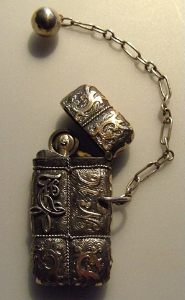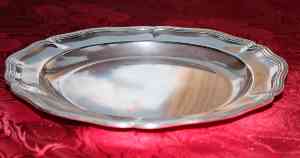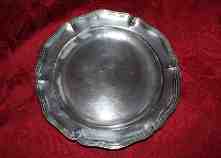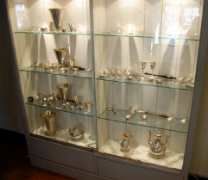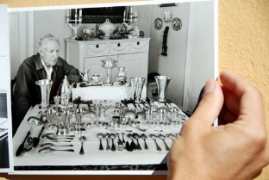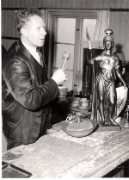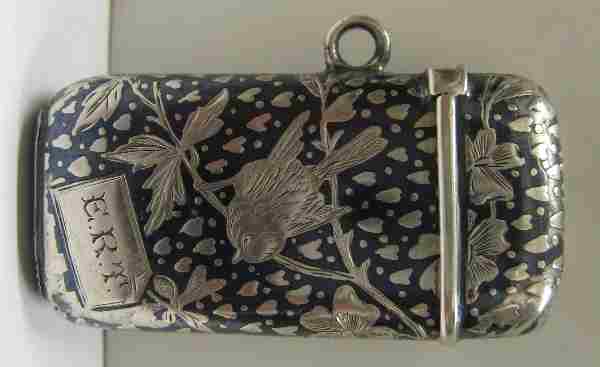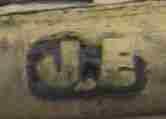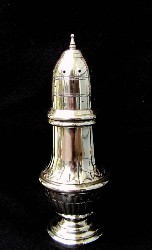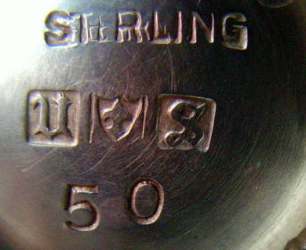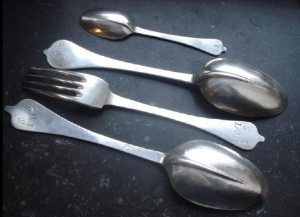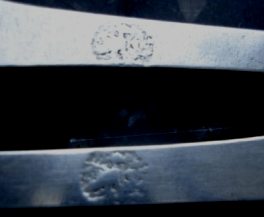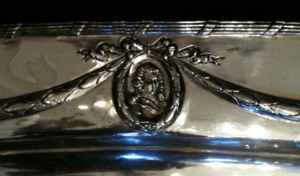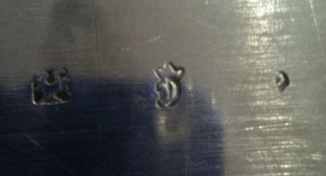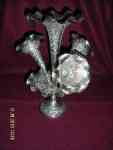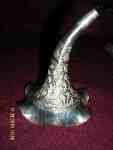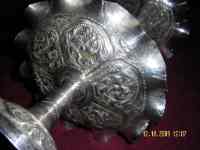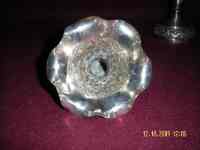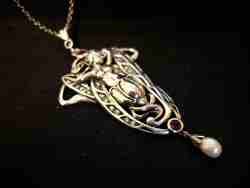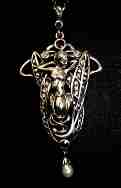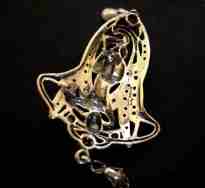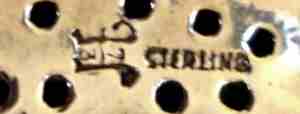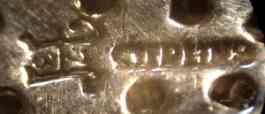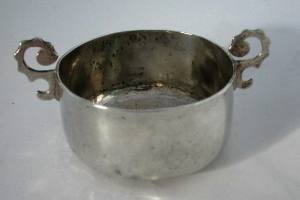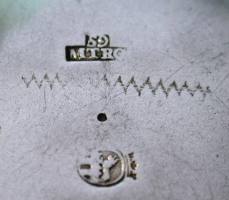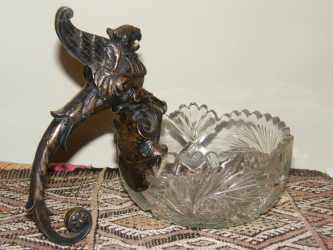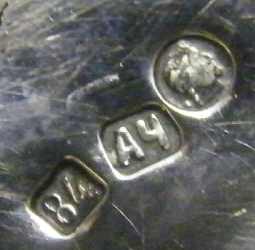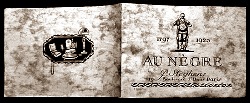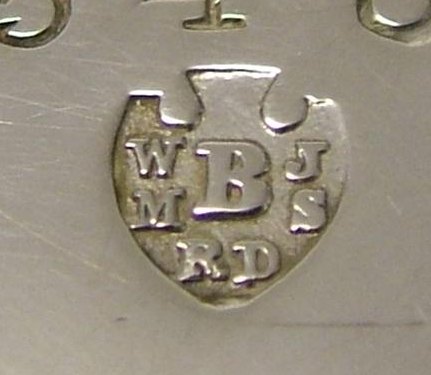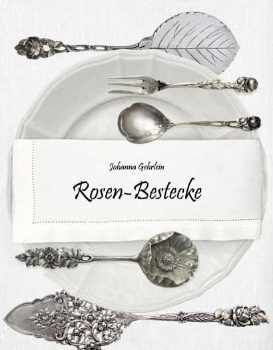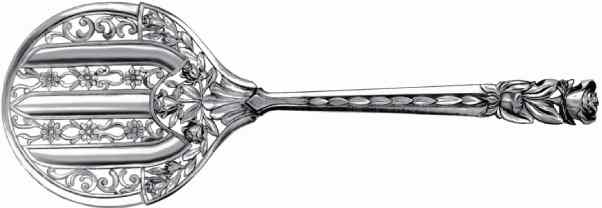 newsletter
# 69 FEBRUARY 2010 newsletter
# 69 FEBRUARY 2010www.ASCASonline.org SITE MAP email: silverassociation@yahoo.it |
|||||||||||||||||
New membersWelcome to new ASCAS members:Michael Bathrick - USA
|
|
top page -
page map |
Members' Window # 69
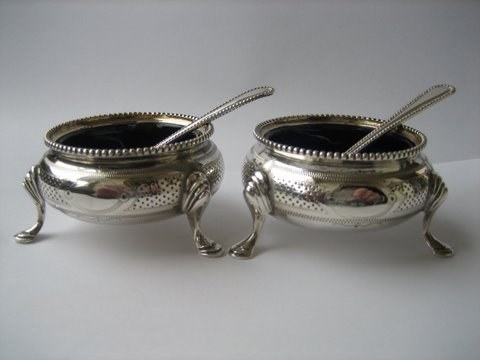
Robert Massart presents:
|
Mail to ASCAS: e-mail silverassociation@yahoo.it
Philippe Dupont writes:
...I have a French silver 18th century plate bearing on the
bottom a set of figures of which I'm unable to understand the
meaning (possibly an ancient weight's measure).
The plate's diameter is 28 cm. and its weight is 876 grams.
Any information will be highly appreciated.
Très cordialement.
Philippe Dupont.
The figures are a later addition (19th-20th
century) and refer to common weight measures:
- the "M" identifies the "marc" (1 marc = 8 onces)
- the "O" identifies the "once" (ounce) (1 once = 576 grains)
- the "G" identifies the "grain".
The weight of these measures is slightly different according to
the Region. Assuming 30,59 grams per once the weight of the
plate was 887,50 grams (3 marcs, 5 onces, 7 1/2 grains).
The hallmarks correspond to: Dijon 1759-1760 (G), silversmith
Mathieu Brunot, active for 50 years, from 1732 to 1782.
Christophe Ginter
Jessica Lovett writes:
...Long ago, my great grandmother had a silver cross. We had
several pictures of her wearing it. Her name was Florence Jessie
Sims Reed. My grandmother had been allowed to wear it a few
times. Unfortunately, no one knows what has happened to the
cross since my great grandmother passed away in Wales in 1945.
We found an old letter that had described the cross as if it was
of some significance, and while researching the family tree
thought we should track the meaning of the figures on the back
of the cross. On the back of the cross, it looked like there
were several images punched into the metal.
The first square had the letters TJS...or FJS it is really hard
to tell from the handwriting. Then there were a series of 3
punched marks: an Anchor, a lion and a small "b". From your site
it looks like this description best matches Birmingham 1901????
Can you verify if that sounds accurate???
But I still have no Idea what the TJS or FJS in the first square
stands for..... if it is FJS.... could it be her
initials...Florence Jessie Sims ??????
I also found your site very interesting due to my family
history... Florence Jessie Sims was married to Ralph Newbury
Reed. He was the son of William Bateman Reed. William Bateman
Reed was the son of Thomas Reed and Matilda Bateman. Matilda
Bateman was the Daughter of William and Ann Bateman. Could there
be any connection to the Bateman and Reed Silversmiths???
I am very anxious for your reply.
Sincerely,
Jessica Lovett
A small "b" was used in 1799 and 1876 but in both
cases the hallmark was accompanied by the "duty mark" in the
shape of the "King's or Queen's head". The duty mark isn't
quoted in your document and the only compatible date is 1901.
The maker’s mark TJS belongs to Thomas James Skelton, Vyse
Street, Birmingham. Skelton was recorded as jeweller (he
registered his mark also in Chester Assay Office) and is
reasonable to think that the cross was made short before the
date of hallmarking.
I have no information about links between Bateman and Reed (by
the way, William Bateman I was the son of Jonathan and Ann
Bateman while William Bateman II was the son of William Bateman
I).
I'm unable to supply further information about the maker or the
object (moreover without an image of it).
Any further suggestion or correction by ASCAS members will be
welcome.
Giorgio Busetto
Jim Nord writes:
...I have a silver ladle from Sweden (cat's paw) that has a Date
mark of T4 (1849?) and a makers mark of AW.
The item is 43 centimeters in length (silver bowl/ladle is 16
centimeters; black handle with white bead on top is 27
centimeters).
On the outside of the silver ladle are etched two sets of
cursive initials.
One set is 5 millimeters high and appears to be E C L
The second set is 8 millimeters high and appears to be K L D
I am attaching photos of the item along with some of my uncle's
complete collection which was donated to the city museum in
Soderhamn Sweden. It is my desire to donate this item back to my
Uncle Helge Nord's collection in the Soderhamn Museum.
I am interested in any information to better understand the
history of this item... Maker, Date, City/Town where it was
made, identifying the Script Initials on the outside of the
ladle, etc.
Can someone help me in my research?
Jim Nord
I trust in ASCAS members to answer your question
Giorgio Busetto
***ANSWERS PUBLISHED IN MARCH 2010 NEWSLETTER***
Carmelo Bruno Bruni writes:
...I am researching information about the marks of this vesta
case. I identified the town mark (London), duty mark (Queen
Victoria) and date letter (G=1882).
I'm unable to identify the other marks (F inside a circle and
maker's mark J.E). Thanks for your help.
Bruno
The J.E mark refers to Joseph Ettlinger partner of
Triefus & Ettlinger, 103 Rue du Temple, Paris. The "F"
identifies an imported item.
Giorgio Busetto
Joao Garcia Branco writes:
...I live in Portugal and I purchased a Sterling Silver Sugar
Caster. However, I don't recognize the Marks.
Can you please help me identify the marks of this piece?
Kind regards
Joao
Your caster was presumably made in the U.S., but I'm
unable to identify the maker.
I trust in the help of ASCAS members.
Giorgio Busetto
Philippe Cocriamont writes:
...Can someone tell me how old those spoons are, and does
somebody know who the silversmith is? The spoons have all one
hallmark, a bird walking to the right. I researched everywhere,
even in the Silvermuseum Sterckshof in Antwerpen: nobody can
help me. It is a mystery.
The spoons have different owner marks, and were bought in
different shops, although all in Ghent (Belgium).
Thanks for your help.
Philippe Cocriamont
Spoons and fork of "dog-nose" shape (read further
information below).
A new challenge for our experts on Belgian/Flemish silver.
Giorgio Busetto
Andrew Brasch writes:
...Dear Giorgio, I recently purchased this beautiful silver tray
but I am a little confused with the silver mark. I recognise the
Austro-Hungarian Diana head but I can't locate the "pitcher"
next to it.
I checked it, it is not from Montpellier.
If you want, place it on the monthly Newsletter.
Your help is appreciated, I always enjoy all the comments in the
Newsletter
Andrew Brasch
The "pitcher" is the figural maker's mark of Eduard
Friedman, active in Vienna from 1881 to 1919.
Giorgio Busetto
Nancy Stuckwisch writes:
...I was wondering if I could get some help identifying a set of
marks. A photo is attached. The item is a large silver oval tray
with a neoclassical ribbon/swag border connecting to 4 cameos. A
detailed photo of ribbon/swag/cameo is also attached.
The decorative elements have a Swedish - Gustavian feel, but the
double eagle makes me think I am completely on the wrong track.
I would be deeply grateful for any assistance.
Many thanks,
Nancy
Your item is a "Hanau silver" made in Germany at the end
of the 19th c/ beginning 20th c.
In ASCAS website you can find articles dealing with this matter
at
http://www.ascasonline.org/windowlugli50.html and
http://www.ascasonline.org/articolox15.html.
I'm unable to identify the maker.
Giorgio Busetto
***ANSWER PUBLISHED IN MARCH 2010 NEWSLETTER***
Adriaan ter Meulen writes:
...This epergne was purchased in Rye, East Sussex, UK from an
antique dealer.
My wife had been looking for one as she was taking lessons in
flower arranging. This antique dealer found one and I believe we
paid about 20 Pound Sterling for it.
This was in the 1986 to 1990 period. There are no markings on it
and as the copper base material is visible in a few spots, it is
obviously plated. The plating seems primitive as in a few areas
drop-like streaks are visible, suggesting that the silver is
thicker in those areas.
I would be pleased to learn more about it.
There are photos attached of the epergne. It is 29 cm high.
Thank you for your help.
Adriaan ter Meulen
I believe that without any mark isn't possible to trace
the origin of your epergne (or posy holder).
I publish these images, but I'm highly doubtful that
satisfactory answers to this question will be forthcoming.
Giorgio Busetto
Meagan (Bee) O'Hara writes:
...Hello, and thank you in advance for any help or assistance
you may be able to offer me. I have stumbled across a gorgeous
pendant, and though my education as a gemmologist is priceless
to me, I am unable to determine the correct origin/person/etc of
the maker's mark.
I have included a few pictures some taken through my microscope.
The pendant features a 1/2 nude woman with detail that is
impeccable. There are 3 pigeon's blood rubies (all bezel set one
of which is set into the bail), 2 opals (both bezel set), 29
hand cut diamonds (all VVS1-SI1 ranging on color from D-G), and
a fresh water pearl drop at the bottom.
It is stamped "Sterling" and also with an "H" that has the
numbers "7" and "3" - the 7 in the top area of the H and the 3
in the lower area.
The H with the 7 and 3 I have assumed means this piece was made
circa 1873.
I am curious to know if this is what I have years ago seen
referred to as a "date ladder"? I assume this pendant's age in
part because each of the 29 diamonds are hand cut, and no two of
them are cut to the same exact specifications.
(I know without a shadow of a doubt that this pendant isn't from
1973). I may be wrong, yet I could have sworn that Nouveau
(which this seems to stylistically fit to perfection) started
around 1890. Can you please help me?
Any information you could offer me about this piece would be
much appreciated.
I do not feel that I can accurately appraise the piece with so
little knowledge of its creation.
Thank you, again.
Sincerely,
Meagan (Bee) O'Hara
Any information will be welcome.
Giorgio Busetto
H. Dinerstein writes:
...I am attaching an image of a 2-handled cup and hallmark. I
cannot trace the mark. Perhaps you could help.
Yours sincerely
H. Dinerstein
The mark is totally unknown to me. The help of ASCAS
members is needed.
Giorgio Busetto
***ANSWERS PUBLISHED IN MARCH 2010 NEWSLETTER***
Helen Eyre writes:
...I’ve been trying to research a silver apostle spoon that an
old lady left to me and quite by accident found a picture of a
similar spoon on your website
http://www.silvercollection.it/pagina55.html. The hallmarks
on my spoon are almost identical to the one you describe as a
Dutch import of 1892 – lion, letter R, letter F etc.
I wonder if you can tell me anything more about it? I’ve
attached a picture – not very good I’m afraid!
Helen Eyre
My web page is now updated with further information about
the spoon:
The English import marks refers to London, 1892, sponsor's mark
of Lewis Lewis (mark entered in 1887).
The origin of this firm refers to Hyman Lewis and Benjamin Lewis
(jewellers and silversmiths) trading in Brighton , Sussex, as
Lewis & Son. Their partnership was dissolved in 1849 and the
business was continued by Benjamin Lewis.
After the death of Benjamin Lewis the trade continued as Lewis &
Son, gold and silversmiths, dealers and importers of antique
plate, etc. From 1887 the business was managed by Barrow Lewis,
Lewis Lewis and Herbert Hyman Lewis. Lewis Lewis died in 1908.
This is the mark of my spoon
Giorgio Busetto
Replies to questions
Jan & Tony Spicer receive this reply about
their Russian centerpiece
(see December 2009 Newsletter)
'Postnikov' writes:
Here is the answer for the request of Jan & Tony Spicer:
This is one of the many total fakes on the market. The object is
plain fantasy and there are no similar exemplars existing in
Russia history.
The round stamp (kokoshnik with dot on the left) should be the
regional confirming stamp of Moscow 1899-1908 for small parts.
The other mark should be the master mark of the silversmith,
unfortunately his name is unknown, working in the year 1744 (!)
and the 84 should be the silver content (875/1000), in this form
never used. An obligatory assay master is totally missing. All
the marks are totally senseless and wrong/non-existing. The
whole object is fantasy, the style and bad quality typical for
the countless Polish forgeries. Mostly the parts are not silver
or silver with very low content.
Hope this helps
Kind Regards
Postnikov
"A PAGE per MONTH"
In this column we present a page
obtained from makers' brochures, books, auction catalogs,
advertising or whatever other printed paper, related to silver,
that may be of interest for ASCAS members.
The images will be published at a "low resolution" level and for
private and personal use only
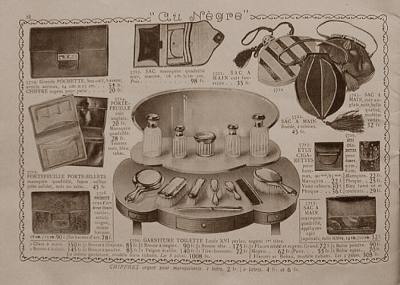
|
This month ASCAS presents a page of an ancient
catalog edited c. 1925 by
|
"A WORD per MONTH"
In this column we
present an abstract from a page of the "What is? Silver
Dictionary"
courtesy of


|
DOG-NOSE SPOON
|
"A SILVERSMITH per MONTH"
In this column
we present marks, information and history of silversmiths and
silver manufacturers.
This column is published under the kind permission of Giorgio
Busetto's website 
EDWARD BARNARD & SONSPossibly the oldest
manufacturing silversmith in the world, the origin of
this business having been established by Anthony Nelme
c. 1680. Francis Nelme succeeded the business on the
death of his father in 1722 and continued until 1739
when Thomas Whipham took over the business. On his death
in 1756 his son Thomas Whipham jr took into partnership
Charles Wright. Thomas retired in 1775 and the business
was continued by Charles Wright. The business was
amalgamated by Henry Chawner in 1786....
|
"A BOOK ON MY SHELF"
In this column we present books, new
or ancient, dealing with silver in all its aspects (history,
marks, oddities...). This isn't a "book review" but only a fair
presentation of some useful "tools" that anyone may have in the
shelf of his bookcase.
ASCAS members are invited to contribute to this column
(click to enlarge images)
The "book on my shelf" of this month presents:
by
Johanna Gehrlein
(Cutlery in Roses Pattern)
ISBN # 978-3-9813273-0-4
Johanna Gehrlein
(Cutlery in Roses Pattern)
ISBN # 978-3-9813273-0-4
By time and while she has learned to
count every rose leaf, rose hip, flower's number of petal,
branches surface be rough or smooth, branches structure twisted
like in "Sleeping Beauty" or straight like skyscraper? Structure
of handle in jig saw pattern or closed?
Then she has started to look where these "Sleeping Beauty" come
from. How they were designed, mould made, cast, finished by jig
saw, file, then polished up, textured by oxidation and signed as
well. Each of these is "unique"!
She found a main source of production in Hanau area of Germany -
products distributed in Germany, as well to the globes
population. And there were many other sources in Germany to -
like from Pforzheim, e.g. CW (W in a "circle") = Christoph
Widmann.
Mrs. Gehrlein were so fascinated, that these "Sleeping Beauty"
came out of little workshop, as well out of big factory of
cutlery maker. And she started to research not only origin of
"Sleeping Beauty"; but also history of maker, their marks, their
whole seller and their marks. Here now she describes about 100
company and workshop, their ancestor and descendant as well - on
some of them never before was anything published!
Maker's mark is shown from every company or workshop, if ever
these marks have existed. Because some never have marked her
products - reason e.g. they were producer for others e.g. whole
seller.
This is a strong output of Mrs. Gehrlein work: You could find
the source of many not marked item to; because she has observed
every detail of item not marked and has described and
photographed very detailed these differences of not marked ones.
But the ever best one I've found in her book is, she show also
BAD STRUCK MARK'S - now some nightmare and collector's headache
be solved before they start! Nothing could be better - maybe she
is the first who has introduced this collector's assistance in a
published monograph?
My favour pattern is "Rose 300" of Wilhelm Ludwig, designed in
1949 by Prof. Bernd Oehmichen, then after, second time he is
director of "Hanauer Zeichenakademie". I'm fascinated because
this is a part of a "Corporate Image" he developed in Products,
Packaging, Prints and Presentation on the market - like Peter
Behrens for AEG.
There is one lemon sweet: It's in German - but from prehistory
on our ancestors and now we are in kindergarten look to and
learn from pictures. I think if you be really interested, you
would learn very quickly the meaning of main word in
descriptions, if you look to the shown photo.
That's now compressed in a book of 304 pages, more then 1,000
black and white, duotone and colour illustration; many of these
photos in original dimension for direct opportunity of
comparisons with self collected item. 1,380 g - of course not a
collector's pocket book, if you like to stroll with this on flea
markets.
Oskar M. Zurell
"A CREST per MONTH"
In this column we present images and descriptions of Crests and Mottoes of British, Irish and Scottish families as engraved on silver items.
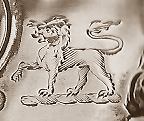 |
FAIRFAXA Yorkshire family. A lion
passant.
|
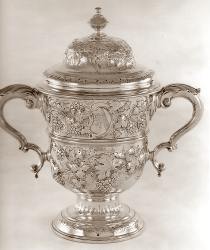 |
Closing our February 2010 edition of ASCAS Newsletter I hope you have appreciated its content.
Your comments, suggestions and advice will be of great help.
My thanks to Joao Garcia Branco, Andrew Brasch, Carmelo Bruno Bruni, Philippe Cocriamont, H. Dinerstein, Philippe Dupont, Jayne Dye, Helen Eyre, Jessica Lovett, Robert Massart, Adriaan ter Meulen, Jim Nord, Meagan (Bee) O'Hara, Postnikov, Nancy Stuckwisch for their invaluable contributions.
Giorgio Busetto
Secretary
ASCAS is a community of people having a common
interest in antique silver.
|
